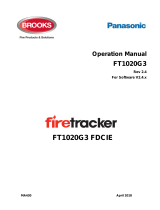
Page 5 of 10
Weekly Maintenance
These checks would normally be carried out by a responsible member of the building sta. They
should also be carried out by the service engineer after all routine maintenance checks.
Note: When reference is made to the controller, the actions should be carried out / checked on all
repeater units tted on the system.
The re alarm system testing should be in accordance with applicable local installation codes.
The following checks should be made:-
a) If necessary, clean the front panel of the controller with a suitable cleansing agent. i.e. anti
static cleansing wipes.
b) Set one device (a call point ) from one zone into alarm, at the call point insert the test key
provided into slot in bottom of call point, check that the system responds as follows:-
i) The controller’s internal buzzer sounds in a continuous tone.
ii) The common red “FIRE” symbol on the controller front panel illuminates.
iii) The appropriate red “FIRE ZONE” LED on the controller front panel ashes.
iv) The general and zonal sounders operate.
v) The xenon beacons operate.
vi) The alphanumeric display gives the location of the alarm.
vii) The repeater panel indicates the same information as the main control panel.
viii) The appropriate plant shutdown operates.
c) Record the device used to initiate the test in the site log book. Accept the alarm on the main
re alarm control panel and reset system via appropriate function pushes on control panel.
d) Check the condition of the printout on the printer attached to the system and replace the
thermal paper if it is becoming faint.
e) Ensure that the printer has an adequate supply of paper.
f) Contact monitoring control room to conrm test signal was received and signal is now in
normal status. Conrm tests are now completed.
Any defect should be recorded in the Fire Alarm System log book and appropriate action taken.
Six monthly maintenance should be based on a risk assessment, taking into account the type of
system installed, the environment in which it operates in and other factors that may aect the
long term operation of the system as per applicable local installation codes.
!
WARN ALL PERSONNEL THAT THE SOUNDERS ARE ABOUT TO BE TESTED.
TELEPHONE CENTRAL STATION AND INFORM THEM THAT A TEST IS ABOUT
TO TAKE PLACE












